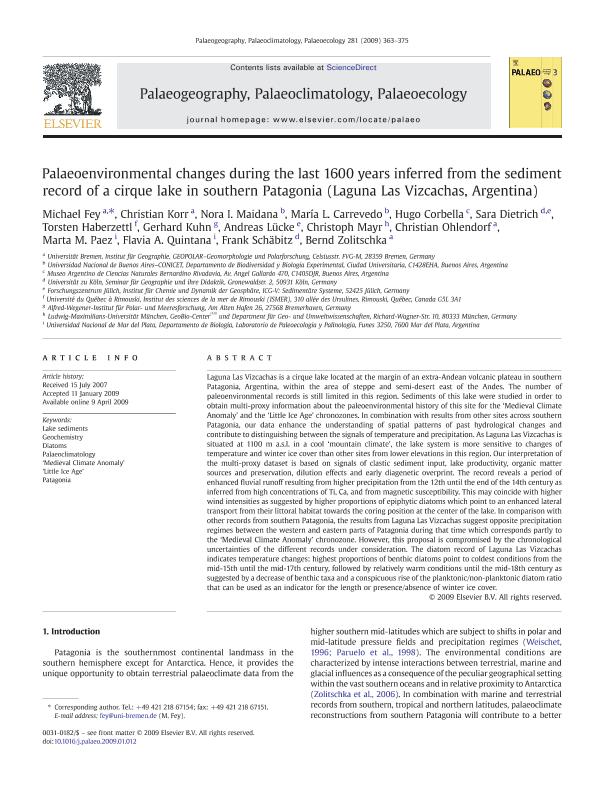Artículo
Palaeoenvironmental changes during the last 1600 years inferred from the sediment record of a cirque lake in southern Patagonia (Laguna Las Vizcachas, Argentina)
Fey, Michael; Korr, Christian; Maidana, Nora Irene ; Carrevedo, María Laura
; Carrevedo, María Laura ; Corbella, Jorge Hugo
; Corbella, Jorge Hugo ; Dietrich, Sara; Haberzettl, Torsten; Kuhn, Gerhard; Lücke, Andreas; Mayr, Christoph; Ohlendorf, Christian; Paez, Marta Mercedes; Quintana, Flavia Andrea
; Dietrich, Sara; Haberzettl, Torsten; Kuhn, Gerhard; Lücke, Andreas; Mayr, Christoph; Ohlendorf, Christian; Paez, Marta Mercedes; Quintana, Flavia Andrea ; Schäbitz, Frank; Zolitschka, Bernd
; Schäbitz, Frank; Zolitschka, Bernd
 ; Carrevedo, María Laura
; Carrevedo, María Laura ; Corbella, Jorge Hugo
; Corbella, Jorge Hugo ; Dietrich, Sara; Haberzettl, Torsten; Kuhn, Gerhard; Lücke, Andreas; Mayr, Christoph; Ohlendorf, Christian; Paez, Marta Mercedes; Quintana, Flavia Andrea
; Dietrich, Sara; Haberzettl, Torsten; Kuhn, Gerhard; Lücke, Andreas; Mayr, Christoph; Ohlendorf, Christian; Paez, Marta Mercedes; Quintana, Flavia Andrea ; Schäbitz, Frank; Zolitschka, Bernd
; Schäbitz, Frank; Zolitschka, Bernd
Fecha de publicación:
10/2009
Editorial:
Elsevier Science
Revista:
Palaeogeography, Palaeoclimatology, Palaeoecology
ISSN:
0031-0182
Idioma:
Inglés
Tipo de recurso:
Artículo publicado
Clasificación temática:
Resumen
Laguna Las Vizcachas is a cirque lake located at the margin of an extra-Andean volcanic plateau in southern Patagonia, Argentina, within the area of steppe and semi-desert east of the Andes. The number of paleoenvironmental records is still limited in this region. Sediments of this lake were studied in order to obtain multi-proxy information about the paleoenvironmental history of this site for the ?Medieval Climate Anomaly? and the ?Little Ice Age? chronozones. In combination with results from other sites across southern Patagonia, our data enhance the understanding of spatial patterns of past hydrological changes and contribute to distinguishing between the signals of temperature and precipitation. As Laguna Las Vizcachas is situated at 1100 m a.s.l. in a cool ?mountain climate?, the lake system is more sensitive to changes of temperature and winter ice cover than other sites from lower elevations in this region. Our interpretation of the multi-proxy dataset is based on signals of clastic sediment input, lake productivity, organic matter sources and preservation, dilution effects and early diagenetic overprint. The record reveals a period of enhanced fluvial runoff resulting from higher precipitation from the 12th until the end of the 14th century as inferred from high concentrations of Ti, Ca, and from magnetic susceptibility. This may coincide with higher wind intensities as suggested by higher proportions of epiphytic diatoms which point to an enhanced lateral transport from their littoral habitat towards the coring position at the center of the lake. In comparison with other records from southern Patagonia, the results from Laguna Las Vizcachas suggest opposite precipitation regimes between the western and eastern parts of Patagonia during that time which corresponds partly to the ?Medieval Climate Anomaly? chronozone. However, this proposal is compromised by the chronological uncertainties of the different records under consideration. The diatom record of Laguna Las Vizcachas indicates temperature changes: highest proportions of benthic diatoms point to coldest conditions from the mid-15th until the mid-17th century, followed by relatively warm conditions until the mid-18th century as suggested by a decrease of benthic taxa and a conspicuous rise of the planktonic/non-planktonic diatom ratio that can be used as an indicator for the length or presence/absence of winter ice cover.
Archivos asociados
Licencia
Identificadores
Colecciones
Articulos(INIBIOMA)
Articulos de INST. DE INVEST.EN BIODIVERSIDAD Y MEDIOAMBIENTE
Articulos de INST. DE INVEST.EN BIODIVERSIDAD Y MEDIOAMBIENTE
Articulos(MACNBR)
Articulos de MUSEO ARG.DE CS.NAT "BERNARDINO RIVADAVIA"
Articulos de MUSEO ARG.DE CS.NAT "BERNARDINO RIVADAVIA"
Articulos(OCA CIUDAD UNIVERSITARIA)
Articulos de OFICINA DE COORDINACION ADMINISTRATIVA CIUDAD UNIVERSITARIA
Articulos de OFICINA DE COORDINACION ADMINISTRATIVA CIUDAD UNIVERSITARIA
Citación
Fey, Michael; Korr, Christian; Maidana, Nora Irene; Carrevedo, María Laura; Corbella, Jorge Hugo; et al.; Palaeoenvironmental changes during the last 1600 years inferred from the sediment record of a cirque lake in southern Patagonia (Laguna Las Vizcachas, Argentina); Elsevier Science; Palaeogeography, Palaeoclimatology, Palaeoecology; 281; 3-4; 10-2009; 363-375
Compartir
Altmétricas



